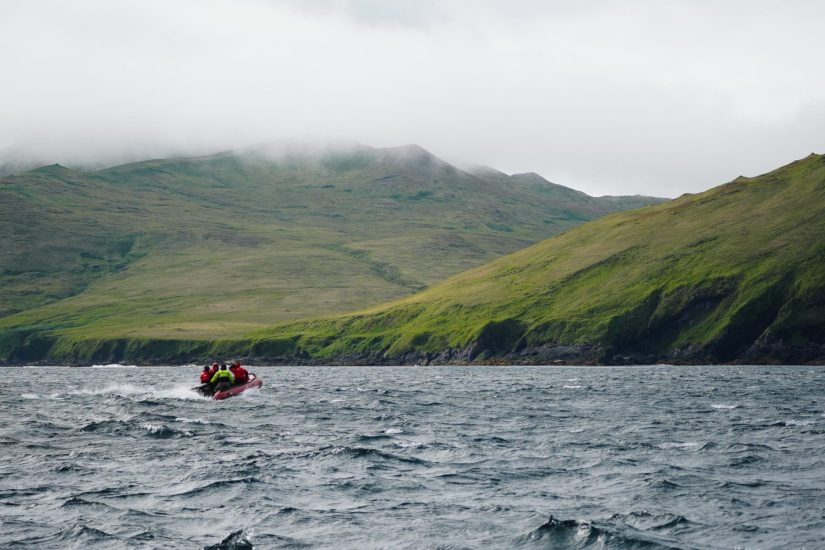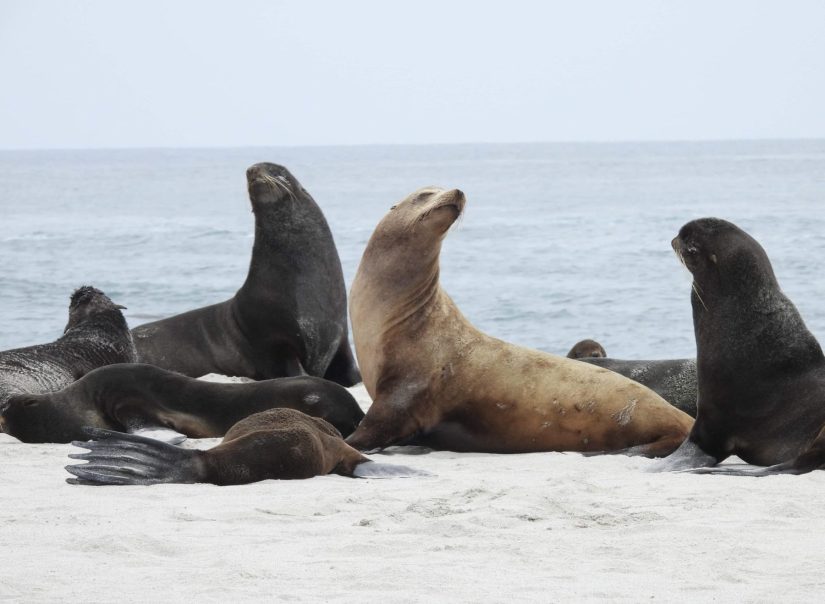NOAA Marine Mammal Laboratory Internships
The Marine Mammal Laboratory, a division of the NOAA Alaska Fisheries Science Center, conducts research on whales, seals, sea lions and porpoises off the coasts of Alaska, Washington, Oregon, and California.
Each year, as part of the School of Aquatic and Fishery Sciences – Marine Mammal Laboratory internship program, students from UW spend a month in the field collecting data on marine mammal behavior, population dynamics, life history, migration patterns, distribution, and trends in abundance. Read about their experiences below.
2025 internship projects TBD
2024 Projects
Alaska pinniped projects: remote camera imagery and food habits
Interns: Kenna Dailey and Sofia Denkovski
Mentor: Molly McCormley and Katie Luxa, Marine Mammal Laboratory, Alaska Fisheries Science Center, NOAA
During June-August 2024, Kenna Dailey and Sofia Denkovski split their time working on two Alaska pinniped projects: remote camera imagery and food habits. Under mentor Molly McCormley, they helped assess the efficacy of NOAA’s machine learning model for detecting Steller sea lions in digital images. They manually reviewed over 21,000 images of Steller sea lions rookery sites in the Aleutian Islands, marking locations of branded sea lion individuals which will be compared to observations found by the machine learning model. Under mentor Katie Luxa, Kenna and Sofia processed ~300 frozen Steller sea lion and northern fur seal diet samples (i.e., scats and spews). The fish otoliths, bones, and squid beaks they recovered from samples are now ready to be identified by Marine Mammal Lab staff. They also helped prep northern fur seal vibrissae for stable isotope analysis and inventoried over 1600 cephalopod specimens in the Lab’s food habits reference collection.
In addition to their research tasks, Kenna and Sofia used this unique opportunity to connect with other MML and Alaska Fisheries Science Center researchers, setting up one-on-one meetings to learn more about their study animals and research projects. Their mentors reported that Kenna and Sofia did a fantastic job. They were enthusiastic, their work was impeccable, and they asked excellent questions. Both Kenna and Sofia have been invited to stay on as part-time (<4 hrs/week) lab volunteers.

2023 Projects
Project: Steller sea lion remote camera imagery
Intern: Samantha Lynn-Martinez
Mentor: Molly McCormley and Carey Kuhn, Marine Mammal Laboratory, Alaska Fisheries Science Center, NOAA
During 10 weeks in the summer of 2023, Samantha-Lynn Martinez worked on a project focused on manually processing Stellar sea lion remote camera imagery data. The main overarching goal of the project is to assess the efficacy of NOAA’s machine learning model to manual observations for all six Steller sea lion rookery sites. During the internship, Samantha-Lynn also spent 2.5 weeks in the field assisting the AEP Program Leader with ship-based Steller sea lion field work in the Aleutian Islands. She also did remote camera image processing work under the supervision of Molly McCormley, which entailed entailed manually looking through a years’ worth of images from 2018, to compare to what the machine learning algorithm pulled out.
Samantha processed around 52,000 images and found over 400 instances of branded Steller sea lions, and her mentor reported that Samantha-Lynn was a fantastic intern, a fast learner, and recommended her to the NOAA communications department, who she is now interning for.

Project: Northern fur seal and Steller sea lion entanglement in plastic debris in Russian waters
Intern: Cindy Wang
Mentor: Tom Gelatt and Vladimir Burkanov, Marine Mammal Laboratory, Alaska Fisheries Science Center, NOAA
During the past two decades MML has conducted intensive surveys of Steller sea lion and northern fur seals in the remote westernmost parts of their range on Russian rookeries and haulouts. Several methods were used for data collection; traditional visual counts on land with binoculars and handheld digital cameras with telephoto lenses; collecting images from certain parts of the rookeries or haulouts using custom-built remote high-resolution digital cameras; using drones to fly over animals resting on land to collect vertical photos from low altitudes. In a project spanning 10 weeks during the summer of 2023, Cindy Wang worked under the supervision of Vladimir Burkanov to complete the statistical analysis on the NFS entanglement data collected on the Tuleny I. NFS rookery in 2021 and 2022. She also reviewed the Steller sea lion images from three sites in different geographical regions of the Russian Far East; the Sakhalin (Tuleny), Kurils (Brat Chirpoev), and Commanders (Medny/YV rookery) to compare the entanglement rates in different regions.
Cindy provided a very informative draft report on NFS entanglement statistics, and her mentor reported that Cindy displayed good statistical skills and interest in continuing the work on the dataset she received.
Project: Population abundance, vital rate estimates, and foraging ecology of California sea lions and northern fur seals at San Miguel Island, California
Intern: Ashley Rendon
Mentor: Tony Orr, Research Biologist, Alaska Fisheries Science Center, NOAA
Ashley Rendon was selected as the California Current Ecosystem Program’s intern as part of the 2023 School of Aquatic and Fishery Science – Marine Mammal Laboratory Summer Internship Program. The project looked at population abundance, vital rate estimates, and foraging ecology of Caligornia sea lions and northern fur seals, and Ashley traveled to San Miguel Island in California. Ashley was trained and participated in activities (primarily with California sea lions and northern fur seals), including: sighting efforts of marked (via brand and/or tag), entangled (with fishing or marine debris), and shark-lesioned individuals; collection of fecal and tissue (vibrissae, teeth) samples for dietary and foraging ecological studies; counting and stacking dead pups for pup mortality estimates; serving as a second counter for live-pup ground censuses; serving as a visual observer of uncrewed aerial system (UAS) activities (i.e. live-pup aerial censuses, aerial sights of marked individuals); and helped in necropsies for the collection of tissues from non-pup individuals for a domoic-acid outbreak study. Additionally, Ashley was responsible for making sure her data were entered into electronic data templates.
Her mentor noted that she worked with competency, professionalism, and a positive attitude.

Project: Assessing bowhead and beluga whale distribution using satellite imagery
Intern: Sara Ghandour
Mentor: Kim Goetz (Alaska Fisheries Science Center, NOAA) and Christin Khan (Northeast Fisheries Science Center, NOAA)
Selected to be part of an internship involving examining very high-resolution satellite imagery collected in Arctic waters to annotate sightings of cetaceans and other noteworthy objects, was Sara Ghandour, a Junior majoring in Marine Biology. Imagery exists for two study areas: 1) Norton Sound, where the target species is the beluga; and 2) Beaufort Sea, where the target species is the bowhead whale.
Sara focused her 10-week internship on annotating beluga whales in high-resolution imagery tasked over Cook Inlet, Alaska. The work entailed following detailed protocols to manually scan and annotate whales in sub-meter satellite imagery. Sara’s mentors described her as enthusiastic, adaptable, and a great communicator.